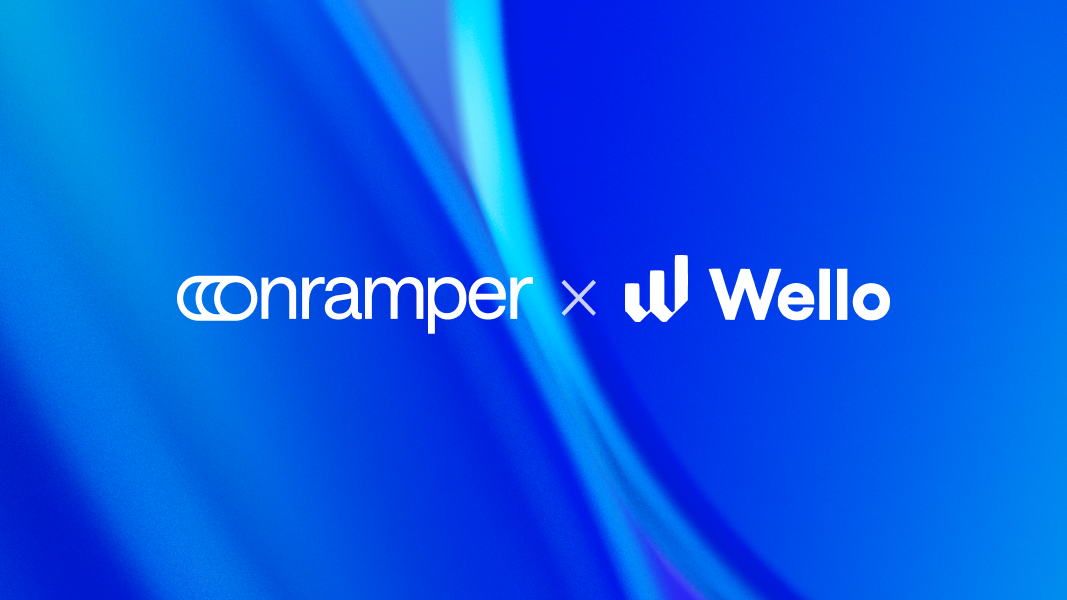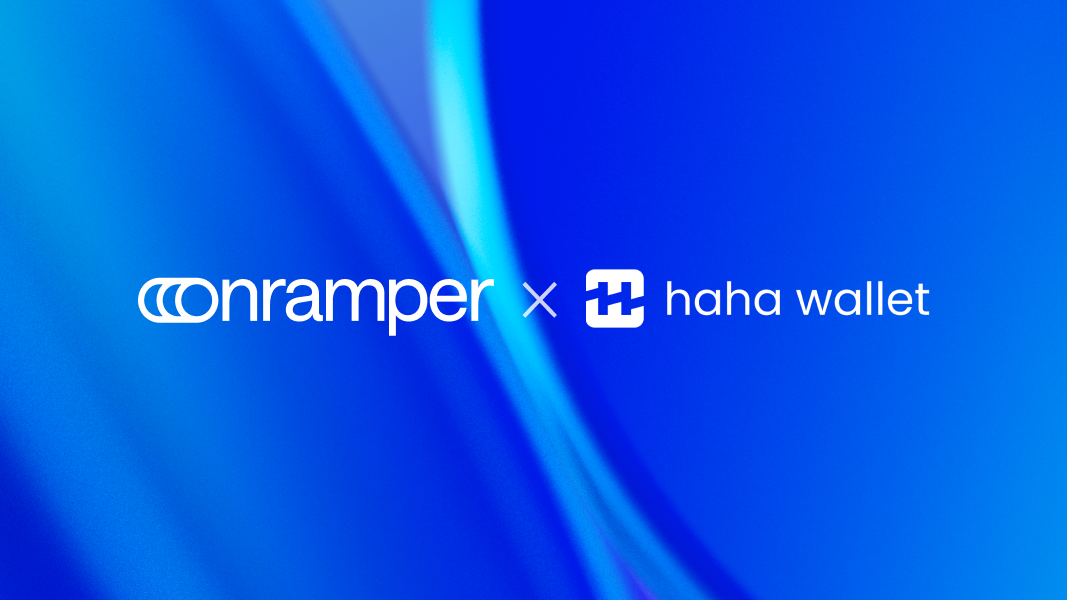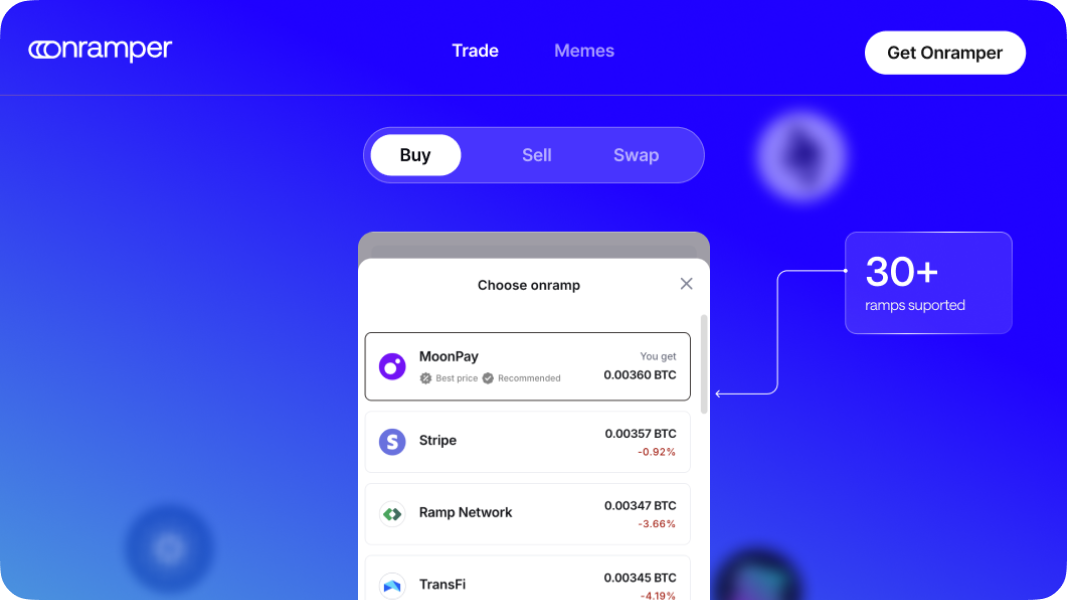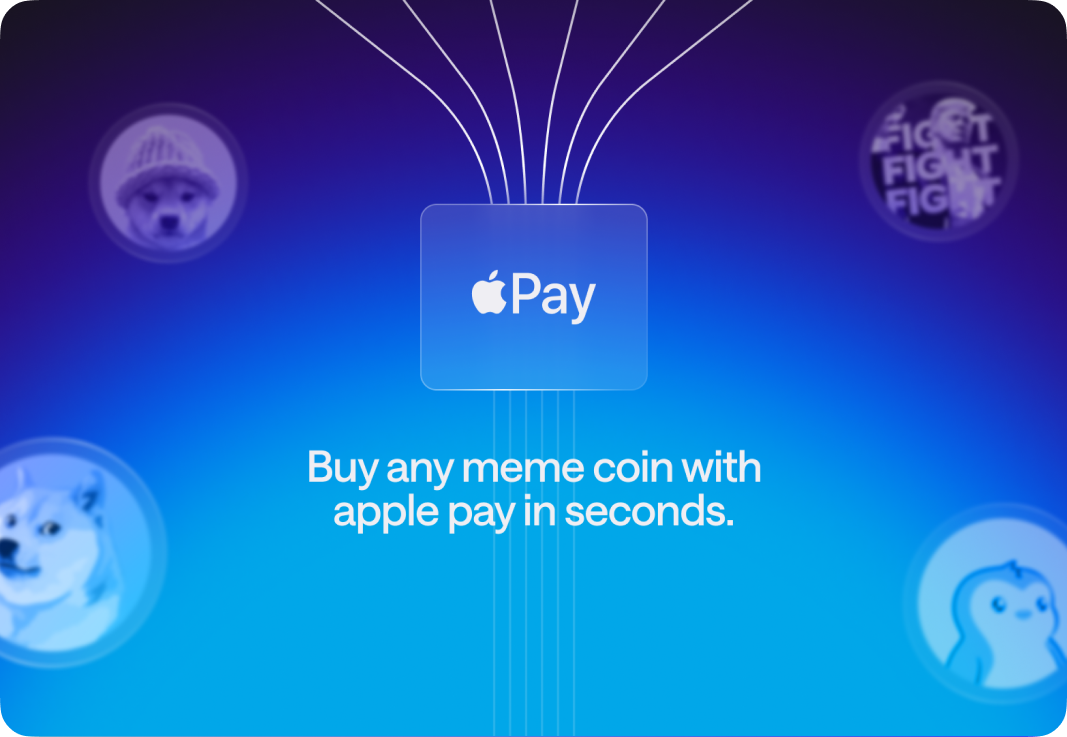Blog
What’s the best fiat onramp for crypto platforms?
Overwhelmed by onramp choices? Our guide simplifies the process, helping you select the right fiat-to-crypto solution for your business.

Considering integrating an onramp into your Web3 or crypto platform? That’s a smart decision.
By doing so, you remove a lot of friction for your customers. Instead of sending them away to figure out how to buy crypto on their own, you can offer an easy portal to convert fiat — right on your website.
With so many onramping options on the market, you may be wondering which is right for you. The short answer? It depends.
The longer answer is what we’re about to discuss.
What is a fiat onramp?
Let’s get our definition clear first. Technically, an onramp is any solution that allows a user to swap fiat currency for cryptocurrency. These range from in-person, local trades to leading centralized exchanges like Binance or Coinbase.
For our purposes, we’re talking about integrated solutions: widgets that live on your website, which enable users to pay for crypto with cards, bank transfers or other payment methods.
What are the best onramping solutions?
In a sea of offerings, several stand out — usually due to some combination of robust security, smooth UI/UX, decent coverage, and a range of supported payment methods and fiat/cryptocurrencies.
In no particular order, some of the top onramps today include:
- MoonPay
- Transak
- UTORG
- Itez
- Coinify
- Wyre
- Mercuryo
- Binance Connect
- Banxa
- Onramp Money
That’s quite a list, isn’t it? Well, that's just the tip of the iceberg. Each one will vary slightly in the regions it covers, as well as its fees and supported input/output currencies.
Wondering what’s right for your dApp, exchange or wallet? Here’s what you should consider:
Your customers’ location
The worlds of crypto and web3 may be global, but if you’re only using one onramp, you’ll need to choose which regions to optimize for. Unfortunately, none of these providers can offer global coverage.
Because of the complexities of converting fiat into crypto, onramps need to be selective in which fiat currencies and payment methods they focus on.
If you’re dealing exclusively with European users, a fiat onramp that specializes in European payment methods and SEPA transactions makes sense: Transak, Coinify or Indacoin are good examples of these.
Finding that the bulk of your customers are attempting to onboard in the U.S. with their debit cards? Wyre may be the solution for you. It’s licensed at both the state and federal level, and doesn’t require KYC for transactions under $1,000.
If your traffic hails from Southeast Asia, Simplex or XanPool may be superior, due to their wide support for the region’s local payment methods.
The fees
Location concerns aside, the fee conversation can’t be avoided. And, frustratingly, it’s not as simple as comparing whatever each onramp offers as a percentage: even with the same advertised fee, your customers will receive different outputs.
Why? Because of the hidden costs — which include things like conversion rates, spreads and network fees.
Consider a customer that wants to buy $1,000 in BTC. There are two onramps available to them:
- Onramp A has a 2% fee and a conversion rate of $21,000/BTC
- Onramp B has a 3% fee and a conversion rate of $20,000/BTC
Without knowing the conversion rate, we’d assume that Onramp A has the better deal. But the customer would only receive 0.0467 BTC, versus the 0.0485 BTC they’d receive if they used Onramp B.
In reality, Onramp A is ~3.7% more expensive!
Above all, think about success rates
Just because it’s the best onramp for most customers doesn’t mean it’s the best solution for them. Inevitably, some are going to get left behind — and not for the reason you think.
When a user begins their transaction, the onramp takes into account many factors (where they’re located, how they’re trying to pay, what currencies they’re interested in). Through some obscure, on-the-fly process, it makes a snap decision as to whether the swap can be completed.
The gold standard for measuring an onramp’s effectiveness is through its success rates: usually expressed as a percentage, this tells us how many of its transactions are actually completed. Spoiler alert: less than half of them are.
Again, that’s down to the sheer number of variables that differ from user to user — which leaves a lot of room for things to go wrong. But a single onramp, in isolation, just doesn’t have the scope to account for such vast differences. At best, it can refine its offering to focus on a tiny segment.
Fifteen onramps are better than one
It’s a frustrating dilemma. For any given user, there’s a perfect onramp. But it won’t always be the one you’ve set up.
Integrating several onramps isn’t really a viable option: maintenance alone would eat up a significant portion of your dev resources. What’s more, without a ‘smart’ routing system, your users would still need to trial-and-error their way through the available options.
Fortunately, you don’t need to concern yourself with the technical overheads. That’s what fiat onramp aggregators are for. Onramper, for instance, immediately makes over fifteen onramps available to wallets, dApps, exchanges, and other businesses who need to ensure their users can get access to crypto.
At its core is an industry-leading, proprietary routing engine that takes into account over 70 factors for each user. In real time, it can automatically pair them with the onramp most likely to ensure success — all while fetching the best fees.
As for integration and maintenance? You don’t need to worry about that. Find out how easy getting started is here, or hop on a call with us to discuss how Onramper can turbocharge your success rates.
Other articles

Wello Joins Onramper’s Network to Expand Crypto Onboarding in Nigeria
Collaboration strengthens Onramper’s Nigerian payment rails for all partners
December 19, 2025 – Onramper, the world’s leading fiat-to-crypto onramp aggregator, announced that it has integrated Wello, a global fiat on- and off-ramp provider, to increase crypto accessibility in Nigeria. By integrating with Onramper, Wello’s localized payment rails will reach a wider audience, beginning with Nigeria and expanding across Asia. This partnership is part of the broader plan to bring stablecoin-powered payments to local markets around the world.
Nigeria remains one of the most active crypto markets globally, but ensuring reliable and high-performing fiat-to-crypto rails in the country remains a challenge. By incorporating Wello’s localized infrastructure, Onramper strengthens its presence in the region and delivers smoother, more successful conversion paths for every partner operating in Nigeria.
“Wello will strengthen the global coverage of our aggregation engine,” said Thijs Maas, CEO of Onramper. “Its dependable and deeply localized infrastructure gives our partners, and their users, the onboarding experience they expect, in Africa and beyond.”
Wello brings strong regional expertise across Africa and the Middle East, with payment rails designed for fast-growing, high-adoption crypto markets. Its localized approach reduces failed transactions and improves uptime for Nigerian users.
Onramper continues to lead the onramp aggregation space, connecting more than 30 global fiat gateways and supporting over 2,000 digital assets. All partners integrated with Onramper will automatically gain access to Wello’s rails, unlocking improved payment methods, stronger reliability, and broader coverage in Nigeria without requiring any technical changes.
“Our goal is to build dependable stablecoin payment rails for users around the world,” said Helen Hai, Co-Founder at Wello. “Partnering with Onramper makes our infrastructure available to more wallets, exchanges, and platforms, unlocking a smoother, more efficient onboarding experience.”
Onramper’s global network supports more than 130 payment methods across 190+ countries. Its smart routing engine recommends the best available conversion in real time, maximizing the likelihood of a successful transaction and helping users receive the most crypto for their fiat.
To learn more, please visit onramper.com and wello.tech.
About Onramper
Onramper is the leading fiat-to-crypto payments aggregator, providing a turnkey API-based solution for dynamically routing fiat-to-crypto onramp flows based on algorithms optimizing for conversion, fees and payment methods. Onramper’s platform allows users of clients to buy 2000+ digital assets, in over 190 countries with over 170 payment methods in 120 currencies, with advanced routing options and unified analytics. The company is based in the Netherlands. To learn more about Onramper, visit www.onramper.com.
About Wello
Wello brings real utility to stablecoins. With compliant fiat on/off ramps, instant QR payments, and cross-border settlement. Wello’s mission is to bridge Web3 with real-world payments, empowering people to send global, spend local, effortlessly.

HaHa Wallet Partners with Onramper to Expand Access to the Monad Ecosystem
Partnership follows Monad Mainnet launch to unlock global onboarding
AMSTERDAM, Dec. 17, 2025 — Onramper, the world’s leading fiat-to-crypto onramp aggregator, today announced a strategic partnership with HaHa Wallet, next-generation, Monad-native crypto wallet, to broaden global accessibility for users engaging with Monad ecosystem.
Through the integration, HaHa Wallet users can now buy crypto using over 130 local payment methods across 190+ countries, benefiting from competitive rates and optimized fees. Following the launch of Monad’s public Mainnet in November 2025, the partnership makes it easier for users worldwide to enter Monad and begin trading, bridging, and exploring dApps.
HaHa Wallet has quickly become a leading gateway into Monad, offering a fast, intuitive, and reward-driven user experience. With Onramper’s global payments coverage and smart routing engine, users can move from fiat to crypto in just a few clicks and start interacting onchain.
“Realizing Monad’s full potential depends on frictionless onboarding,” said Thijs Maas, CEO of Onramper. “Our partnership with HaHa Wallet brings trusted, localized payment access directly into the Monad ecosystem. Together, we’re making it easier than ever for people everywhere to get started on Monad.”
Monad’s unique architecture enables parallel transaction execution, delivering faster speeds, quicker finality, and lower fees without sacrificing decentralization. Combined with Onramper’s global payment infrastructure, HaHa Wallet provides users with a streamlined entry point into Monad’s high-performance blockchain environment.
“Our focus is building the simplest possible entry point into the Monad Ecosystem,” said Mu Li, founder of HaHa Wallet. “Integrating Onramper allows us to offer trusted local payment methods, helping users get onchain quickly and confidently, no matter where they are in the world.”
Onramper continues to lead the onramp aggregation space, connecting more than 30 global fiat gateways and supporting over 2,000 digital assets, driving greater accessibility and inclusivity across Web3.
To learn more, please visit onramper.com and haha.me
About Onramper
Onramper is the leading fiat-to-crypto payments aggregator, providing a turnkey API-based solution for dynamically routing fiat-to-crypto onramp flows based on algorithms optimizing for conversion, fees and payment methods. Onramper’s platform allows users of clients to buy 2000+ digital assets, in over 190 countries with over 130 payment methods in 120 currencies, with advanced routing options and unified analytics. The company is based in the Netherlands. To learn more about Onramper, visit www.onramper.com.
About HaHa Wallet
HaHa Wallet is the Monad native, high performance smart wallet built to maximise how users earn and participate on chain. Purpose built for Monad’s low latency, parallel execution environment, HaHa delivers lightning fast swaps, deep native integrations with Monad dApps and ecosystem campaigns, and seamless access to multiple EVM chains through a single non custodial experience. Users earn Karma for meaningful on chain activity, unlocking rewards, ecosystem access, and future HaHa token utility, positioning HaHa Wallet as the primary consumer gateway to Monad and a rewards driven hub for Web3 participation.
For media enquiries, contact:

Introducing our new crypto trading portal: the easiest way to buy, sell and swap
Buying crypto should be simple. Selling and swapping should feel just as easy. That’s why we’re leveling up the Onramper experience to make this a reality.
Meet our new crypto portal, the world’s simplest all-in-one trading platform. It brings buying, selling and swapping together in one place with the best available fees and full global coverage.
One place for everything
It’s easy for trading flows to feel scattered, with buying, swapping and selling all living in different places. We set out to fix that..
Our portal brings everything together so the entire journey stays clear and straightforward from start to finish. You can now:
- Buy crypto with 170+ payment methods
- Sell back to fiat
- Swap 100K+ assets across 50+ networks, with 11+ liquidity providers
All from one clean, intuitive interface.

Always the best fees, automatically
Crypto pricing moves fast, with fees constantly shifting based on payment method, geography, KYC requirements and liquidity. Our smart routing engine tracks all of it in real time and selects the best provider automatically.
We do the work, and you get the best fees with the highest chance of transaction success.
Any payment method. Any user.
A global product requires global payment coverage. The new portal supports 175+ payment methods including cards, Apple Pay, Google Pay, bank transfers, regional options and alternative methods found in high-growth markets.
Since payment preferences vary by region, the interface automatically highlights the options that perform best in your area. This keeps the experience fast, familiar and easy for any user, anywhere.

Buy any memecoin on Solana with MoonGate
The rise of memecoins has changed what’s expected from a trading experience. People want speed, simplicity and access to the long tail of new tokens.
By integrating MoonGate directly into the portal, we deliver exactly that. You can:
- Sign in with Google or Apple to generate a wallet instantly
- Discover trending Solana tokens
- Buy or swap into any memecoin in seconds
No separate setup and no manual wallet creation. Just instant access.

This is just the beginning
This portal isn’t an add-on. It’s a dedicated page built around a single widget that supports every trade type in one unified experience. And it’s only the first version.
We’ll continue adding new features that streamline the entire trading journey. From smarter token discovery to personalized payment suggestions, our goal is to create the smoothest crypto trading experience possible.
Try the full experience here: https://onramper.webflow.io/buy



















